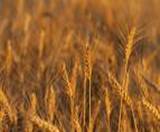| Kingdom | Plantae |
| Unranked | Angiosperms |
| Unranked | Monocots |
| Order | Poales |
| Family | Poaceae |
| Genus | Triticum |
| Species | T. aestivum |
| Binomial name | Triticum aestivum |
Other Common Names:
The other common names for the wheat are Bread Wheat, Canadian Hard Winter Wheat, Common Wheat and Hard Red Winter Wheat.
History
Wheat is a grass like plant. It belongs to the group of grains called cereals. Wheat scientific name is Gramineae and makes up the genus Triticum. Other important cereals are rice, oats, corn, barley and rye. Different kinds of wheat grow successfully in hot, cold and dry conditions. The cultivation of wheat began to spread beyond the Fertile Crescent during the Neolithic period, reaching the Aegean by 8500 cal BC and the Indian subcontinent by 6000 cal BC.

Description
The wheat stem is a continuous tissue made up of several sections. The stem is up to 1.2m tall, erect, simple, multiple from base, forming tufts, typically glabrous, glaucous, annual. The function of roots is to anchor the plant to its substrate and to absorb water and minerals. The leaves are long, broad, glabrous or somewhat strigose, entire, bluish-green. Auricles when present with a slightly wavy margin, scarious. Ligule a short membrane to +/-1mm tall.



Range
Wheat is the main food of hundreds of millions of people throughout the world. As a result, wheat covers more of the earth's surface than any other food crop. Wheat is extremely common in Africa, North and South America, Asia, Australia and Europe.
Habitat
Developed through cultivation, it is not known in a truly wild location. The plant prefers light sandy, medium loamy and heavy clay soils and requires well-drained soil. The plant prefers acid, neutral and basic alkaline soils. It cannot grow in the shade. It requires moist soil. Widely cultivated but also planted along roadsides and in disturbed areas. Escaped to waste ground, railroads.
Cultivation
A good wheat crop depends on several things. The soil and the weather must be right. The seed must be good, and free from diseases. The grain must be harvested at the correct time. Between germination and harvesting, there are in total 150 to 180 days. In some places farmers grow wheat in rotation with other crops. Seeds are sown in early spring or autumn in situ and only just cover the seed. Germination should take place within a few days. This sub-species is most commonly sown in the spring, though it is also sometimes sown in the autumn. The growth cycle of wheat has stages like germination, seedling establishment and leaf production, tillering and head differentiation, stem and head growth, head emergence and flowering, and grain filling and maturity. Adverse environmental conditions during any of the growth periods of a kernel can reduce the rate of dry matter accumulation and decrease yield. As a rule, the longer the adverse condition lasts, and the earlier it occurs during grain filling, the greater its effect on yield.
Parts Used

The of the wheat are the most commonly used parts for its commercial and medicinal purposes.
Flowering Season
The flowers are hermaphrodite an are in bloom from June to July.
Pests and Diseases
Wheat is used as a food plant by the larvae of some Lepidoptera (butterfly and moth) species including The Flame, Rustic Shoulder-knot, Setaceous Hebrew Character and Turnip Moth.
Medicinal Applications
• The pressed oil is used warm to heal tetters and ringworm.


• Wheat-bread poultices made with red wine and applied to hot, inflamed or blood-shot eyes, help them.
• The poultices will heal kernels in the throat. Wheat-flour mixed with the juice of Henbane, stays the flux of humours to the joints.
• Mixed with the yolk of an egg, honey or turpentine it draws cleanses and heals boils, plague sores or foul ulcers. A piece of toasted bread dipped in wine and applied to the stomach, is good to stay vomiting.
• Modern uses. Bread poultices are excellent applied to painful swellings in the body.
• Wheat germ oil is rich in vitamin E and improves circulation.
• The wheat germ itself is rich in vitamins and considered to be an excellent health food.
Commercial Applications


• It is usually ground into flour and used as a cereal.
• The straw has many uses, as a biomass for fuel etc, for thatching, as mulch in the garden.
• A fibre obtained from the stems is used for making paper.
• The fibres make a green-tan paper.
• The starch from the seed is used for laundering, sizing textiles etc.
• It can also be converted to alcohol for use as a fuel.

The sowing, growth, and harvesting of grain, specifically of wheat, have represented birth and death as well as death and rebirth. In ancient Greece, the head of grain, as the fruit of the maternal womb of the earth, symbolized the fruit of the human body; it was a symbol of Demeter and played a central role in the Eleusinian mysteries. In Egypt the growing wheat was regarded as a symbol of Osiris rising from the dead.
In the Middle Ages the grain of wheat signified Christ descending to and resurrected from the underworld. To the present day, the Eucharist is symbolically alluded to on altar furnishings by the images of the ear of grain and the grape. The stalk of wheat, moreover, is a symbol of Mary, for she contained the grains from which came the flour for the host. Mary, depicted in a dress showing ears of grain, is also compared to the field on which Christ, as wheat, could grow.